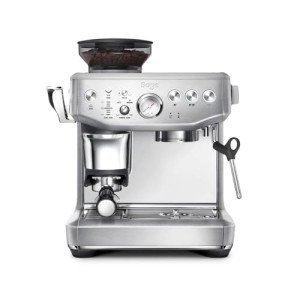Ten Energy-Efficient Espresso Machines That Will Help You Live Better
Energy-Efficient Espresso Machines: A Comprehensive Guide
Worldwide of coffee lovers, espresso machines are frequently considered essential devices for brewing rich, fragrant coffee. Nevertheless, the energy consumption connected with these machines can result in increased energy costs and environmental concerns. As consumers become more eco-conscious, energy-efficient espresso machines have become a popular choice. This post aims to check out the features, benefits, and alternatives readily available in energy-efficient espresso machines, assisting coffee lovers make informed options.
What Makes an Espresso Machine Energy-Efficient?
Energy-efficient espresso machines are designed to lessen energy consumption while keeping optimum efficiency. Several functions add to the energy efficiency of these machines:
Insulation: High-quality insulation assists maintain heat, reducing the energy needed to preserve optimal developing temperature levels.
Smart Technology: Many modern machines are equipped with programmable settings that permit users to set up developing times and change to standby mode when not in use.
Quick Heat-up Time: Energy-efficient espresso machines often use innovative heating technologies, such as thermoblocks or PID controllers, to heat water rapidly.
Low Wattage: Machines that operate at lower wattages take in less energy overall, making them more effective.
Car Shut-off: Automatic shut-off features guarantee that the machine shuts off after a certain duration of lack of exercise, further lowering energy waste.
Advantages of Energy-Efficient Espresso Machines
Purchasing an energy-efficient espresso machine can use a number of advantages:
Cost Savings: Over time, lower energy usage can lead to reduced electrical power costs.
Ecological Impact: Using less energy minimizes carbon footprints, making these machines a more sustainable option for ecologically conscious consumers.
Improved Performance: Many energy-efficient models likewise use exceptional developing innovations, leading to better-tasting espresso.
Resilience: Typically, energy-efficient machines are built with high-quality parts, causing higher longevity.
Features to Consider
When selecting an energy-efficient espresso machine, a number of features must be considered:
- Type of Machine: Options consist of manual, semi-automatic, and totally automatic designs, each with varying degrees of user control and automation.
- Brew Quality: Look for machines that use high-quality brewing systems to guarantee optimum taste extraction.
- Maintenance: Some machines have self-cleaning functions that can conserve energy and effort in maintenance.
- Capacity: Depending on personal or household size, machine capability can affect energy consumption, with larger machines typically requiring more power.
Popular Energy-Efficient Espresso Machines
The market provides a range of energy-efficient espresso machines accommodating different needs and choices. Below are some noteworthy models:
Brand
Model
Secret Features
Energy Consumption
Breville
Barista Express
Integrated grinder, PID temperature level control, quick heat-up.
Low
DeLonghi
EC155
Compact size, easy to use, resilient construct.
Moderate
Rancilio
Silvia
Heavy-duty style, outstanding temperature stability, and has a low environmental effect.
Moderate
Gaggia
Timeless
Reputable manual operation, resilient brass elements, and efficient steaming ability.
Low
Jura
E8
Fully automatic, wise features, and a removable brew group for easy cleaning.
Low
Tips for Optimal Energy Efficiency
Aside from selecting an energy-efficient design, consumers can embrace numerous practices to make the most of energy effectiveness:
- Preheat: If your machine has a pre-heating function, use it to ensure that the optimal temperature is reached quickly before developing.
- Switch off After Use: Always turn off the machine after brewing or make use of machines with auto shut-off functions.
- Routine Maintenance: Keep the machine properly maintained to ensure it runs efficiently and successfully.
FAQs About Energy-Efficient Espresso Machines
1. Are energy-efficient espresso machines more expensive?
While the initial investment may be greater for energy-efficient designs, the long-lasting cost savings on electrical energy expenses can balance out the initial expense. Additionally, numerous energy-efficient machines come with advanced functions that improve the developing experience.
2. How do I know if an espresso machine is energy-efficient?
Try to find indicators such as Energy Star accreditation, user reviews, and specs relating to wattage and heat-up time. Machines with particular features aimed at lowering energy usage are normally developed for much better performance.
3. Can Compact Espresso Machines use an energy-efficient espresso machine for other coffee styles?
Many energy-efficient espresso machines provide versatility, allowing users to brew different coffee styles beyond espresso, such as lattes and cappuccinos, by integrating steaming capabilities.
4. Do energy-efficient designs compromise quality for efficiency?
Not always. Lots of energy-efficient espresso machines are geared up with high-quality brewing technology that can boost taste extraction while reducing energy consumption.
5. What upkeep is needed for energy-efficient espresso machines?
Regular upkeep includes cleaning the machine, descaling when required, and regularly examining seals and gaskets to make sure optimal efficiency and energy efficiency.
Energy-efficient espresso machines represent a perfect blend of performance, savings, and environmental duty. By considering numerous functions, benefits, and brands, consumers can choose a model that matches their special choices while contributing favorably to the environment. As the pattern toward sustainable living grows, the popularity of energy-efficient devices, consisting of espresso machines, is likely to continue its upward trajectory, offering coffee enthusiasts a guilt-free way to enjoy their everyday dose of espresso.
